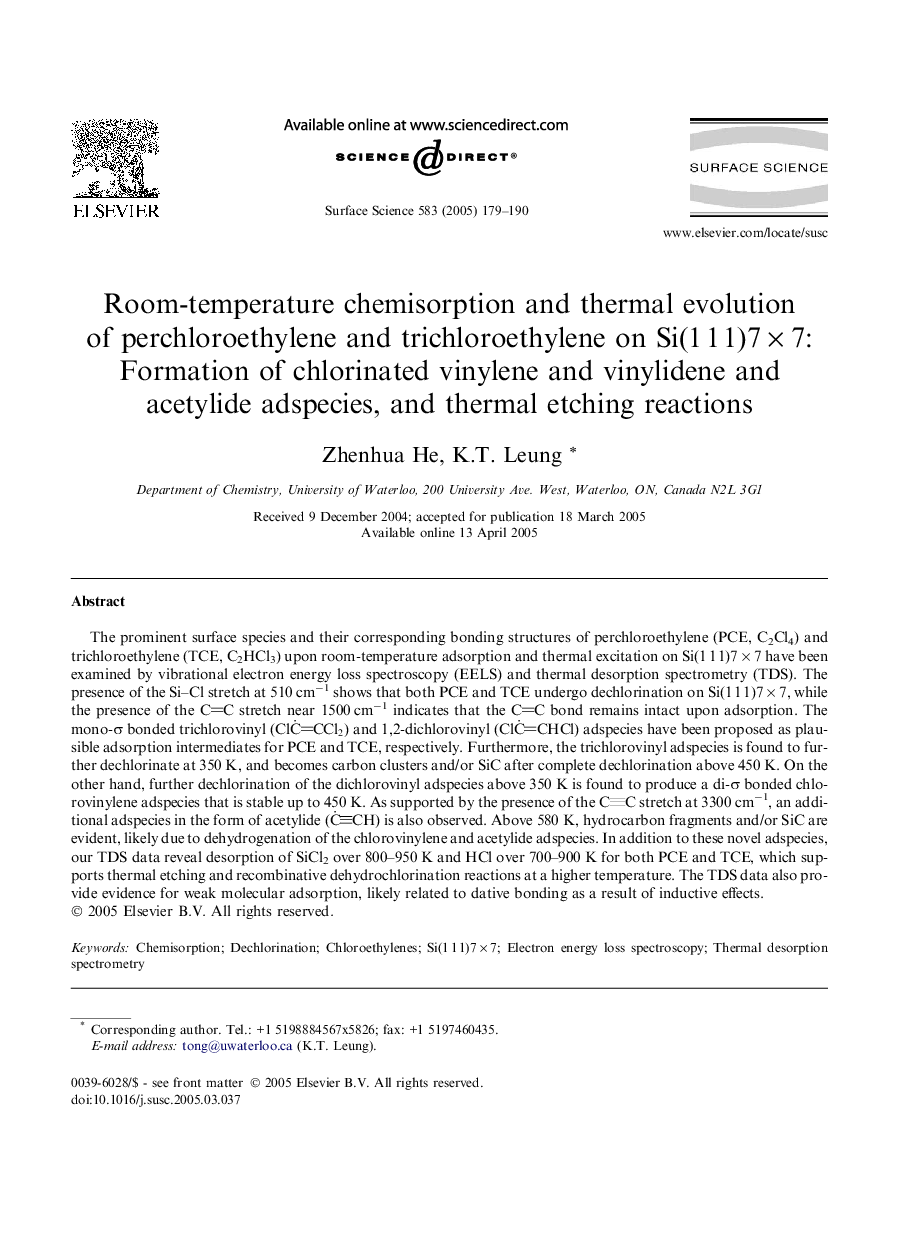| کد مقاله | کد نشریه | سال انتشار | مقاله انگلیسی | نسخه تمام متن |
|---|---|---|---|---|
| 9594731 | 1507976 | 2005 | 12 صفحه PDF | دانلود رایگان |
عنوان انگلیسی مقاله ISI
Room-temperature chemisorption and thermal evolution of perchloroethylene and trichloroethylene on Si(1Â 1Â 1)7Â ÃÂ 7: Formation of chlorinated vinylene and vinylidene and acetylide adspecies, and thermal etching reactions
دانلود مقاله + سفارش ترجمه
دانلود مقاله ISI انگلیسی
رایگان برای ایرانیان
کلمات کلیدی
موضوعات مرتبط
مهندسی و علوم پایه
شیمی
شیمی تئوریک و عملی
پیش نمایش صفحه اول مقاله

چکیده انگلیسی
The prominent surface species and their corresponding bonding structures of perchloroethylene (PCE, C2Cl4) and trichloroethylene (TCE, C2HCl3) upon room-temperature adsorption and thermal excitation on Si(1Â 1Â 1)7Â ÃÂ 7 have been examined by vibrational electron energy loss spectroscopy (EELS) and thermal desorption spectrometry (TDS). The presence of the Si-Cl stretch at 510Â cmâ1 shows that both PCE and TCE undergo dechlorination on Si(1Â 1Â 1)7Â ÃÂ 7, while the presence of the CC stretch near 1500Â cmâ1 indicates that the CC bond remains intact upon adsorption. The mono-Ï bonded trichlorovinyl (ClCËCCl2) and 1,2-dichlorovinyl (ClCËCHCl) adspecies have been proposed as plausible adsorption intermediates for PCE and TCE, respectively. Furthermore, the trichlorovinyl adspecies is found to further dechlorinate at 350Â K, and becomes carbon clusters and/or SiC after complete dechlorination above 450Â K. On the other hand, further dechlorination of the dichlorovinyl adspecies above 350Â K is found to produce a di-Ï bonded chlorovinylene adspecies that is stable up to 450Â K. As supported by the presence of the CC stretch at 3300Â cmâ1, an additional adspecies in the form of acetylide (CËCH) is also observed. Above 580Â K, hydrocarbon fragments and/or SiC are evident, likely due to dehydrogenation of the chlorovinylene and acetylide adspecies. In addition to these novel adspecies, our TDS data reveal desorption of SiCl2 over 800-950Â K and HCl over 700-900Â K for both PCE and TCE, which supports thermal etching and recombinative dehydrochlorination reactions at a higher temperature. The TDS data also provide evidence for weak molecular adsorption, likely related to dative bonding as a result of inductive effects.
ناشر
Database: Elsevier - ScienceDirect (ساینس دایرکت)
Journal: Surface Science - Volume 583, Issues 2â3, 1 June 2005, Pages 179-190
Journal: Surface Science - Volume 583, Issues 2â3, 1 June 2005, Pages 179-190
نویسندگان
Zhenhua He, K.T. Leung,